Original Article
Year: 2020 |Volume: 1 | Issue: 1 |Pages: 1-8
Clinical study of efficacy of Takradhara (Shirodhara) in improving quality of life of Ekakushtha (Psoriasis) Patients.
About Author
Correspondence Address:
Dr. Chetan M. Gulhane. Add: Mira Road, Thane, 401107, India. Email-Id : drchetanayu@gmail.com
Date of Acceptance: 2020-04-06
Date of Publication:2020-05-19
Article-ID:IJIM_1_05_20 http://ijim.co.in
Source of Support: None
Conflict of Interest: None
How To Cite This Article: Gulhane CM, Thakar AB. Clinical study of efficacy of Takradhara (Shirodhara) in improving quality of life of Ekakushtha (Psoriasis) Patients. Int. J Ind. Med. 2020;1(1):1-8.
Abstract
Background: Ekakushtha (psoriasis) is considered as Kshudra Kushtha (Minor Skin Disease) in Ayurveda, But the present scenario psoriasis is one of the severe skin diseases, which is Difficult to manage. Ekakushtha is quite similar to the Psoriasis due to its maximum similarity in chief symptoms. Psoriasis ravages the quality of life (QOL) of afflicted individuals. The aim of present study is to assess the clinical efficacy of Takradhara in improving the quality of life. Material and Method: For present study patients of Psoriasis in between the age of 16 to 60 years, attending the O.P.D and I.P.D of Gujarat Ayurved University, Jamnagar had been selected. Total 14 patients were registered for study in which 12 patients completed and 2 patients were dropped out during treatment. Takradhara therapy was given for 14 days in morning. Clinical efficacy of Takradhara was assessed by Health, Wellness & Quality of Life Questionnaire. Results and Discussion: Psoriasis disturbed psychological status (Manas Bhava) Stress may induce alterations in the psoriatic lesions, in study we found maximum 75.76% patients were under stress due to Change in eating habits & Change in living conditions. After treatment significant results were found in Quality of life of Physical State, Mental/Emotional State, stress, Life Enjoyment & Overall Quality of Life of patients. Conclusion: The obtained results of clinical trial suggest that Takradhara with Amalaki and Musta have highly significant result on the symptoms of Ekakushtha and Improve the quality of life in patients.
Keywords: Ekakushtha, Psoriasis, Takradhara, Buttermilk Therapy. Quality of Life
Introduction
Psoriasis is a non-infectious, papulosquamous chronic, recurrent inflammatory skin disease with genetic predisposition and environmental factors acting as triggers. It is characterized by well-defined erythematous plaques with silvery white scale. The skin cells mature and are shed from the skin’s surface every 28 to 30 days.[1] When psoriasis develops, the skin cells mature quicker in 3 to 6 days and move to surface of skin. Instead of being shed, the skin cells pile up causing the visible lesions. Psoriasis is a disease with worldwide prevalence of 1–3%.[2] In India prevalence is 0.44–2.8%.[3] Ekakushtha comes under Kshudrakushtha[4] (Minor skin disease). In Ayurveda the symptoms of psoriasis mentioned as[5] Mahavastu (Bigger lesions are found all over the body & deeply rooted), Matsya Shakalopamam (Well-defined raised macules, papules, & erythematic plaques found which covered with silvery scales.), Krishna Aruna Varna[6] (The lesions are raised & erythematous thick lesion becomes black in color.), Aswedanam (The lesion of this disease are dry & rough, Bhavaprasha mentioned symptom like Mandala-Abhrakapatrasama[7] (lesion-Round and with scaling like mica). which clearly indicates the similarity of Ekakushtha with Psoriasis. Psoriasis affects health-related quality of life to an extent similar to the effects of other chronic diseases, such as Depression, Hypertension, Congestive Heart Failure or Type II Diabetes. Quantification of the impact of psoriasis on the QOL, along with clinical severity assessment, as has been demonstrated in various studies [8],[9] could provide a measure of the clinical efficacy of the dermatological therapies. Survey of National Psoriasis Foundation showed that almost 75% of patients had moderate to large negative impact on their quality of life (QoL), and alterations in their daily activities. Some studies shows 20% of psoriasis patients had contemplated suicide.[10]
Patients with psoriasis have a higher financial burden due to absenteeism in addition to the cost of caring for their disease Stress-induced autonomic response & diminished pituitary-adrenal activity is seen in psoriasis patients[11]. In Ayurveda, Dhara therapy is indicated in Vata- Pitta disorders. Dhara is not only used in psychic diseases but, also used in psychosomatic diseases like psoriasis. Dhara is done by different medicaments like Taila, Takra, Kshira, Kwatha etc. In the southern Dhara therapy is most commonly practiced. When Takra (Buttermilk) is poured on head is called Takradhara[12]. Takra has Vata- Kaphaghna properties [13] & can be used locally & internally to treat the Ekakushtha (Psoriasis) which has Vata Kapha dominance [14]. As various studies conducted on Dhara therapy in general and Takradhara in the form of Shirodhara had shown significant results in relieving the stress induced disorder. Takradhara as Shirodhara was given to relieve stress which is most triggering factor of psoriasis. Buttermilk contains large amount of lactic acid. It is scientifically proved that lactic acid is used to moisten & lessen the appearance of thickened psoriatic scales[15].
Aims and objectives
1. To evaluate clinical efficacy of Takradhara in improving the quality of life in the patient of psoriasis. 2. To study the mode of action of Takradhara in psoriasis.
Materials & Methods
1. Selection of patient: Patients suffering from psoriasis were selected from the O.P.D. & I.P.D. of I.P.G.T. & R.A. Hospital, Jamnagar irrespective of religion, sex, occupation & caste etc. 2. Inclusion criteria: age-16 to 60 and patients having classical signs & symptoms of Ekakushtha (psoriasis) were selected. 3. Exclusion criteria: psoriasis associated with HTN, DM, CA, asthma & other systemic diseases. 4. Drug, dose and duration: Takradhara as a Shirodhara was given for 14 days, Time - 30 -45 min
Drug for Takradhara
• Cow Milk-1.5 lit, • Amalaki (Emblica officinalis Gaertn.)- 200 gm, • Musta (Cyperus rotundus Linn.)- 100 gm • Procedure: Takra was prepared by fermenting Musta Shirapaka overnight & next morning Amalaki decoction was added in to it & churned. After removing total cream Takra was used for Dhara.
Criteria for diagnosis:
Patients were diagnosed and assessed thoroughly on the basis of classical signs and symptoms of Ekakushtha (psoriasis) along with positive signs like Auspitz sign, Candle grease sign, Koebner phenomenon. Assessment criteria: • A special proforma was prepared incorporating the classical signs and symptoms of Ekakushtha and special scoring pattern including PASI was adopted for the assessment of results. • Assessment of Quality of life by Heath, Wellness & Quality of life questionnaire[16]. Answer each of the questions with respect to when patient first came to OPD.
Observation and Results
Total 14 patients were registered out of which 12 patients had completed the treatment course and 7 patients get moderate relief in chief complaints and 2 patients became LAMA. Plaque psoriasis was found in 72.4% whereas 12.9% & 9.7 % patients were of erythrodermic & guttate type of psoriasis respectively. According to modern science incidence of Plaque Psoriasis was about 80%[17] (the most common type of psoriasis. Candlegrease Sign & Auspitz sign was found in 100%, of patients & Koebner’s phenomenon was found in 6.4% of patients. After the Takradhara, Maximum 68.96% relief was found in Daha (Burning sensation) & 68.23% relief was found in Srava (discharge), while 55.17 % in Aswedana (Anhydrous), 50 % in Mandala (Erythema) & Bahalatva (Epidermal thickening), 42.8% in Rukshata (Dryness), 61.1% relief was found in Kandu (Itching).Bahalatva (Epidermal thickening) & Srava (discharge) showed significant result P<0.01, while other symptoms showed highly significant P <0.001 result. Physical State: Maximum 42 % relief was found in Incidence of allergies or skin rashes & Incidence of dizziness or light-headedness. 40 % relief was found in Incidence of nausea or constipation & Incidence of colds and flu. Statistically highly significant result P<0.001 were found in All symptoms, except insignificant result P>0.05 was found in Incidence of accidents. Stress Evaluation: Maximum 42.73 % relief was found in stress due to General well-being & 34.78 % relief was found in health related stress. Statistically insignificant result P>0.05 were found in work related stress & sex related stress. While in other symptoms highly statistically significant result P<0.001 were found. Mental/Emotional State: Maximum 50 % relief was found in wariness about small things. 47.72% relief was found in Presence of negative or critical feelings. 46 % relief was found in Difficulty falling or staying asleep & Experience of vague fears or anxiety. Statistically highly significant result P<0.001 were found in All symptoms Life Enjoyment: Maximum 60 % improvement was found in Satisfaction with the level of recreation, followed by 50 % improvement in level of satisfaction with sex life, 48.48% improvement in Incidence of feelings of joy or happiness. Statistically highly significant results P<0.001 were found in All symptoms. Except insignificant result P>0.05 was found in Level of confidence in your ability to deal with adversity. Overall Quality of Life: Maximum 48.7% improvement was found in ability to adjust to change in life. 47.36% improvement was found in personal life. Statistically highly significant results P<0.001 were found in ability to adjust to change in life & accomplishing in life. Overall Impressions in: Maximum73.83% patient said their condition was better, 24.61 % patient said same & 1.54 % patient said Worse.
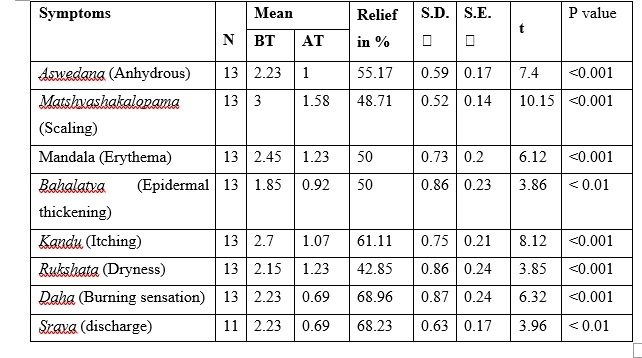
Table No. 1. Effect of Takradhara therapy on symptoms of Psoriasis
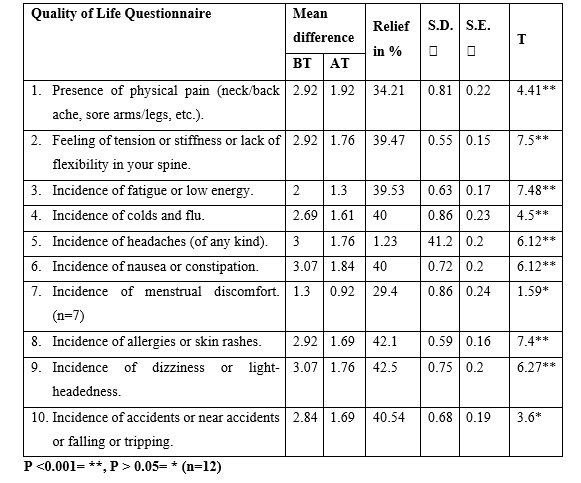
Effect of Takradhara on Health, Wellness & Quality of Life Questionnaire
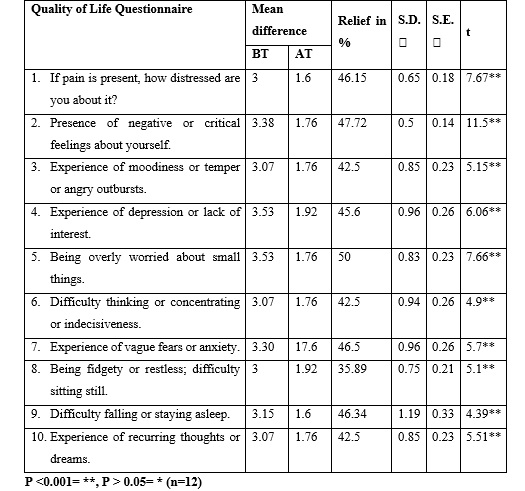
Table: 3. Mental/Emotional State:

Table: 4. Stress Evaluation:
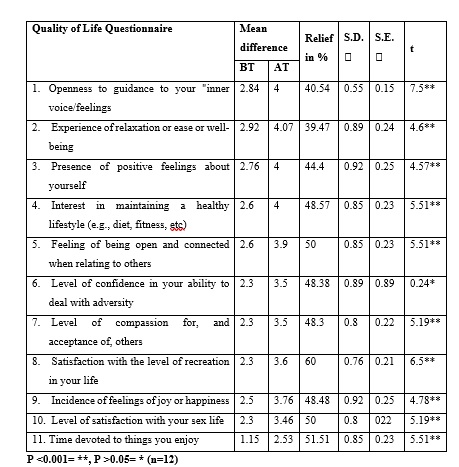
Table: 5. Life Enjoyment :

Table: 6. Overall Quality of Life:
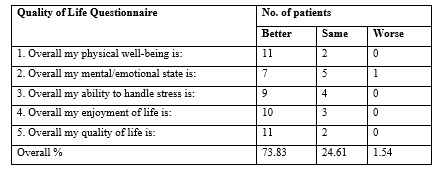
Table: 7. Overall Impressions:
Discussion
Effect on Quality of life: Scale of QOL is selected to assess clinical severity, physical and psychosocial disability, stress incurred and to analyze their interrelationship. Effect on Quality of life of physical state related symptoms (like Incidence of allergies or skin rashes & Incidence of dizziness or light-headedness in these symptoms relief was found. Pruritus, depression, pain, and obstructive sleep apnea may be likely sources of sleep impairment in patients with psoriasis. Dhara therapy gives better result in disturb sleep due to Tranquilizing effect & antidepressant activity.
Probable mode of action actin of Takradhara: In Ayurveda, Dhara therapy is indicated in Vata- Pitta disorders; previous research works show that it gives good results in stress related lifestyle disorders like hypertension, ulcerative colitis, psoriasis & other psychosomatic diseases etc. Buttermilk contains large amount of lactic acid. It is scientifically proved that lactic acid is used to moisten & lessen the appearance of thickened psoriatic scales. lactic acid is available in several commercial moisturizing creams and lotion. Lactic acid present in butter milk helpful in reducing scale and hyperkeratosis by causing softening and desquamation of the stratum corneum. They are most beneficial in extremely thick or scaly psoriatic plaques. [18] Continuous pouring of Takradhara on fore-head for a specific period has Tranquilizing effect & regulates rhythm Mana & Prana Vayu it also induces Sleep[19]. As per Modern science Lactic acid & active ingratiate of Amalaki(Phyllanthus emblica) & Musta(Cyperus rotundus) may pass through the Stratum corneum into blood vessel and producing desirable effects by reaching the target organ. In Shirodhara Continues poring of liquid may effect on Sthapani, Utkshepa Marma & stimulate Gyanchakra in the brain which regulate the rhythm Mana & Prana Vayu which Produce hypnotic effect & regulate neuroendocrine system, it also relieve stress and give relief in symptoms of psoriasis.
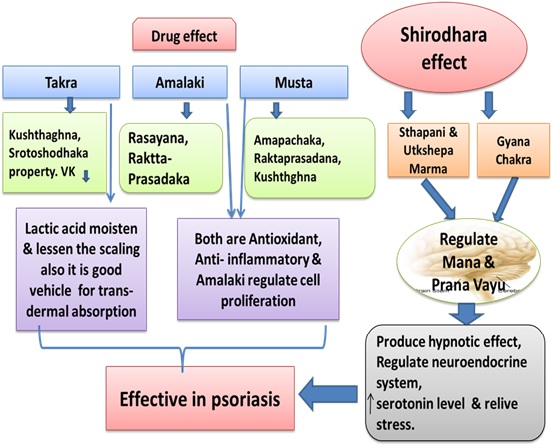
Probable mode of action actin of Takradhara: (fig. no. 1)
Conclusion
Psoriasis is a psychosomatic disease & one of the most triggering factor of disease is Stress. There is strong correlation between etiopathogenesis of disease & stress. Takradhara as a Shirodhara is effective in treating psoriasis, it relieve stress in patients of psoriasis. Quality of Life of psoriasis patients improved in Physical State, Mental/Emotional State & Life Enjoyment after Takradhara. Along with Tranquilizing effect Takradhara regulates rhythm Mana & Prana Vayu it also induces Sleep. As per Modern science Lactic acid & active ingridients of Amalaki & Musta may pass through the Stratum corneum into blood vessel and producing desirable effects by reaching the target organ.
References
value="
- Baker H. Epidermiological aspects of psoriasis and arthritis. Br J Dermatol. 1966;78(5):249-61.
- Parisi R, Symmons DP, Griffiths CE, Ashcroft DM; Identification and Management of Psoriasis and Associated Co morbidity (IMPACT) Project Team. Global epidemiology of psoriasis: A systematic review of incidence and prevalence. J Invest Dermatol 2013;133:377-85.
- Dogra S, Yadav S. Psoriasis in India: Prevalence and pattern. Indian J Dermatol Venereol Leprol 2010;76:595-601.
- Shukla VD, editor, Charaka, Dridhabala, Charaka Samhita, Chikitsa Sthana, Kushthachikista Adhyaya 7/13, second edition, Chaukhamba Sanskrit Pratishthana Varanasi, 2002;182
- Tripathi B, editor. Vagabhata, Astanga Hridaya. Nidana Sthana 14/20, Chaukhamba Sanskrit prathishthan, Delhi.; Reprint 2015; 529
- Shastri A, editor, Sushruta, Nagarjuna , Sushruta Smhita ,Sushruta Nidan Sthana , kushtha Nidana ,5/9, 1st Edition, Chaukhamba Sanskrit Pratishthana Varanasi, 2005;494
- Murthy KR, editor, Bhavamishra, Bhavaprakasha samhita, Madhya Khanda, Kushtha Adhikara 54/25, Krishinadas Academy, Varanacy ,2007;600
- SV Rakhesh, Mariette D'Souza, Ajith Sahai, Quality of life in psoriasis: A study from south India, Indian J Dermatol Venereol Leprol 2008;74:600-6
- Gupta MA, Gupta AK. Age and gender differences in the impact of psoriasis on quality of life. Int J Dermatol 1995;34:700-3
- Krueger G, Koo J, Lebwohl M, Menter A, Stern RS, Rolstad T. The impact of psoriasis on quality of life: results of a 1998 National Psoriasis Foundation patient-membership survey. Arch Dermatol. 2001;137:280–284
- Schmid-Ott, Gerhard, et al. "Stress-induced endocrine and immunological changes in psoriasis patients and healthy controls." Psychotherapy and psychosomatics 67.1 (1998): 37-42.
- N.S. Mooss, editor, Asthavaidyan vayaskara, Ayurvedic treatment of Kerala, Takradhara therapy, published by vaidyasarthy Kottayam
- Murthy KR S, editor, Bhavamishra, Bhavaprakasha samhita, Purva- kanda, Takra Varga 16/3 Krishinadas Academy, Varanacy ,2007; 461
- Shukla VD, editor, Charaka, Dridhabala, Charaka Samhita, Kushthachikista Adhyaya 7/29; second edition, Chaukhamba Sanskrit Pratishthana Varanasi, 2002;185
- Lodén M. Role of topical emollients and moisturizers in the treatment of dry skin barrier disorders. American journal of clinical dermatology. 2003 Nov 1;4(11):771-88.
- Blanks, R. H., Tonya L. Schuster, and Marnie Dobson. "A retrospective assessment of network care using a survey of self-rated health, wellness, and quality of life." Journal of Vertebral Subluxation Research 1.4 (1997): 1.
- Mantovani L, Medaglia M, Piacentini P, Tricca M, Vena GA, Vozza A, Castellino G, Roccia A. Burden of moderate-to-severe plaque psoriasis and new therapeutic approaches (secukinumab): an Italian perspective. Dermatology and therapy. 2016 Jun 1;6(2):151-67.
- Witman PM. Topical therapies for localized psoriasis. InMayo Clinic Proceedings 2001 Sep 1 (Vol. 76, No. 9, pp. 943-949). Elsevier.
- Divya K, Tripathi JS, Tiwari SK. An appraisal of the mechanism of action of shirodhara. Annals of Ayurvedic Medicine. 2013;2:114-7.
"

